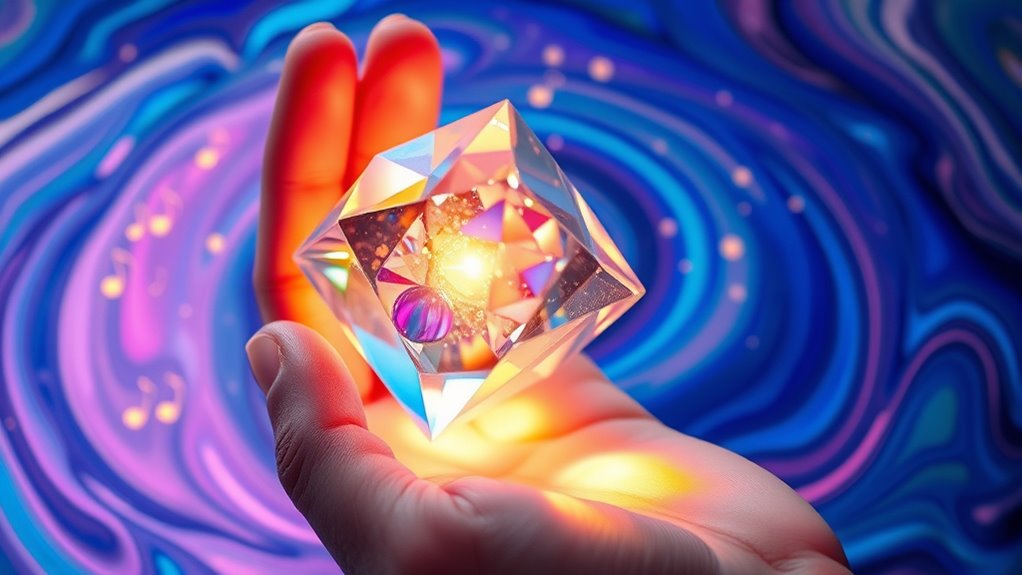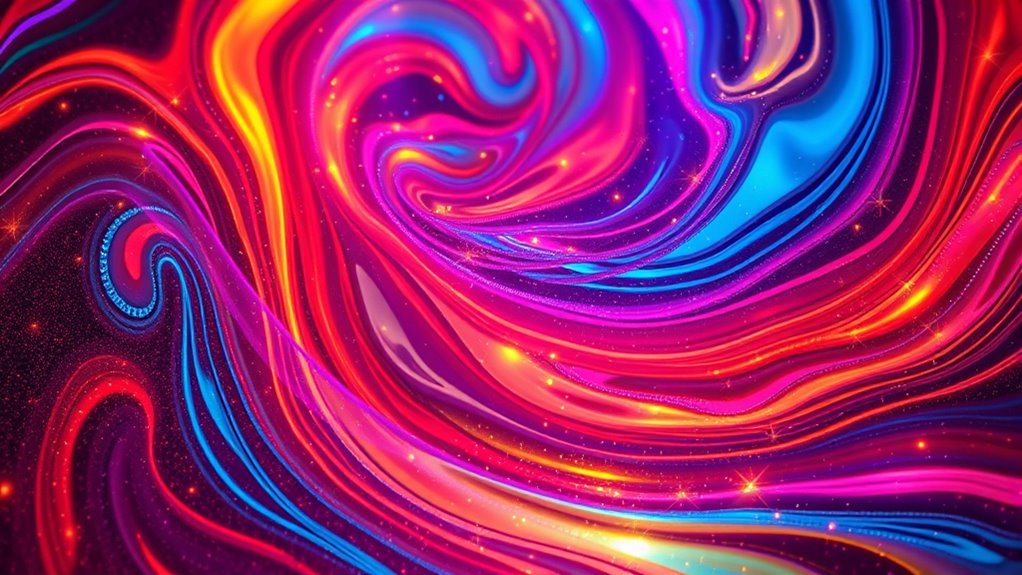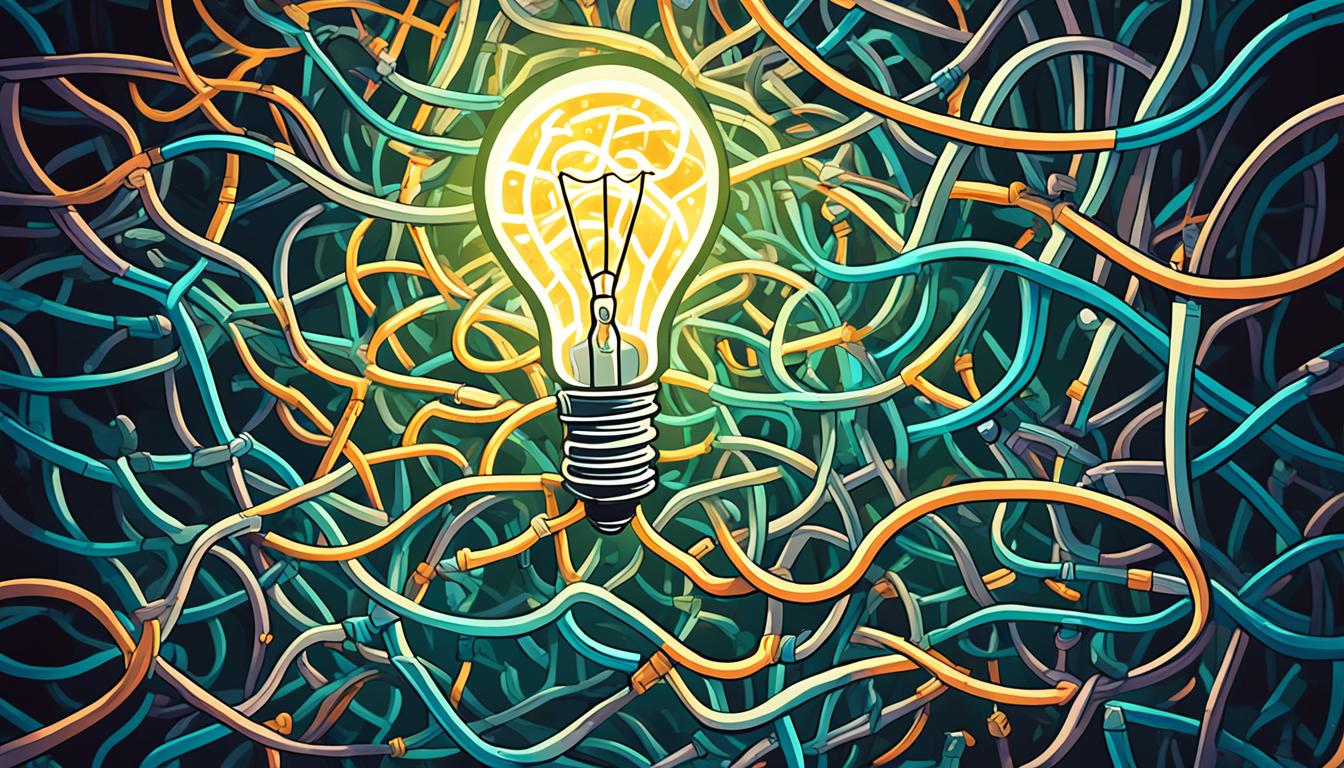Synesthesia is a fascinating condition where your senses merge, creating vivid, blended experiences. You might see colors when listening to music or taste words as you read. This happens because of increased connectivity between sensory areas in your brain, allowing senses to automatically evoke each other. Variations in neural wiring mean everyone’s experience of synesthesia is unique. If you’re curious, exploring more reveals how this blending influences perception, creativity, and artistic expression in remarkable ways.
Key Takeaways
- Synesthesia is a neurological phenomenon where different senses, like sight and sound, automatically intertwine, creating blended perceptions.
- It results from increased neural connectivity or cross-wiring between sensory brain regions.
- Individuals experience unique sensory associations, such as seeing colors when hearing music or tasting words.
- Synesthesia can enhance creativity, inspiring art, music, and poetry through vivid multi-sensory experiences.
- It challenges traditional ideas of perception, showing that sensory boundaries are more flexible than previously thought.

Have you ever experienced seeing colors when hearing music or tasting words? If so, you’re not alone. Synesthesia is a fascinating neurological phenomenon where your senses intertwine, creating a blending of perceptions that most people never encounter. Neuroscientific insights reveal that synesthesia results from increased connectivity between different sensory regions in the brain. Instead of the typical, separate pathways processing each sense, synesthetes have cross-wiring that causes one sensation to automatically evoke another. For example, hearing a certain note might trigger you to see a specific color, or reading a word might evoke a particular taste. These neural differences challenge the way we understand perception and consciousness, suggesting that sensory boundaries are more flexible than previously thought. Additionally, color accuracy in other sensory processing areas may vary among individuals, further illustrating the diversity of perceptual experiences. For artists and creators, synesthesia opens new avenues for expression. Many synesthetes describe their perceptions as a form of artistic gift, allowing them to translate multi-sensory experiences into visual art, music, or poetry. Famous examples include painter Wassily Kandinsky, who reportedly experienced colors when he heard music, and composer Olivier Messiaen, who associated specific scales with colors. These experiences often serve as a wellspring of inspiration, enabling artists to craft works that evoke layered sensations, enriching the emotional depth of their art. It’s as if their brains are constantly translating one sense into another, providing a vivid palette of perceptions that others might struggle to imagine. This blending of senses can make their creative process more intuitive, fostering originality and emotional resonance in their work.
Frequently Asked Questions
Can Synesthesia Be Cured or Treated?
You might wonder if synesthesia can be cured or treated. While there’s no definitive cure, you can explore options like leveraging neuroplasticity potential through targeted therapies to manage symptoms. Pharmacological interventions may help reduce discomfort or enhance coping strategies, but results vary. Remember, synesthesia is a unique perception, and many see it as a gift rather than a condition needing eradication. Always consult a specialist for personalized advice.
Is Synesthesia More Common in Certain Professions?
Imagine you’re in a bustling jazz club, where cross-disciplinary research and artistic expression collide. Synesthesia appears more common among artists, musicians, and writers, as it fuels creativity. This sensory blending helps them visualize sounds or taste colors, enhancing their work. While not exclusive to these professions, their environment encourages exploring synesthesia’s unique perspective, making it a fascinating trait that often thrives amid creative pursuits.
How Does Synesthesia Develop in Children?
You might wonder how synesthesia develops in children. It results from unique developmental pathways that cause sensory blending, where signals from different senses cross or connect abnormally. These pathways form early, influenced by genetics and brain structure. As children grow, their brains refine these connections, sometimes strengthening them into consistent perceptual experiences. Understanding these developmental processes helps explain why some kids experience synesthesia more vividly or frequently.
Are There Different Types of Synesthesia?
Did you know around 4% of the population experiences some form of synesthesia? You might find that there are many types, such as those involving color associations or sensory blending. You could see letters or numbers as colors, or hear sounds when tasting certain foods. These variations make synesthesia a fascinating phenomenon, highlighting how different your sensory experiences can be and how uniquely your brain interprets the world.
What Are the Neurological Causes of Synesthesia?
You might wonder about the neurological causes of synesthesia. It occurs because of neural cross wiring, where the brain’s sensory pathways connect abnormally, leading to enhanced sensory integration. This cross wiring causes one sense to trigger another, creating those unique merging experiences. These differences in neural connections are often genetic, and they make your perception of the world richer and more complex, blending senses in a fascinating way.
Conclusion
So, now you see how synesthesia blurs the lines between senses, transforming ordinary perception into a vivid, multi-sensory symphony. It’s like stepping into a renaissance painting where colors speak and sounds have texture, making your world richer and more complex. While you might feel like you’ve traveled through a portal to another dimension, remember, this phenomenon has been around long before the internet—just another example of how our minds can surprise us, even in the age of smartphones.









